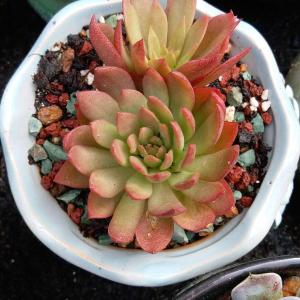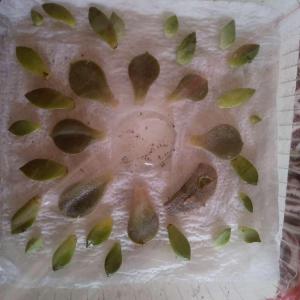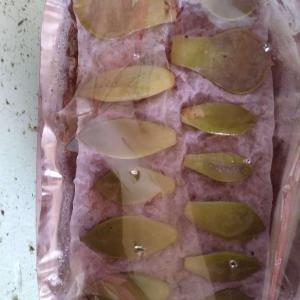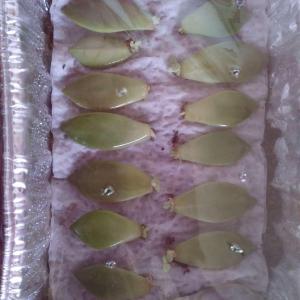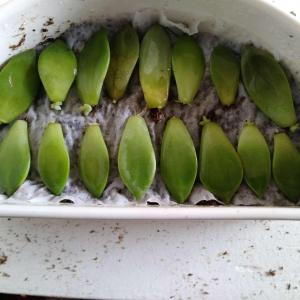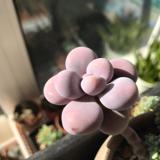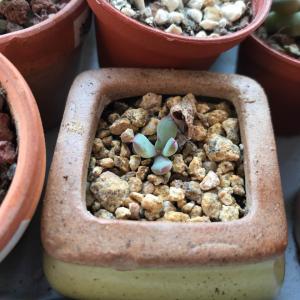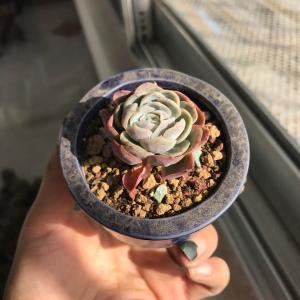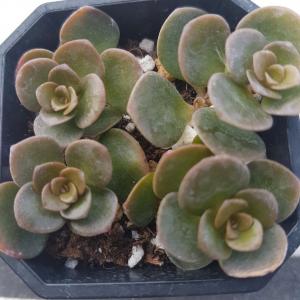成长记
kungmidas
2018年01月05日
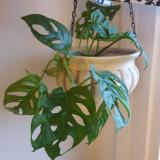
har 4 friska blad plus ett på väg sen efter kattattacken som förstörde en hel del.
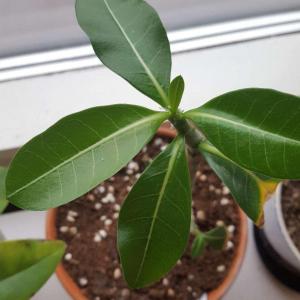

0
1
文章
Miss Chen
2018年01月05日

Description: This herbaceous perennial wildflower is 1-2' tall. The central stem is light green to reddish green, terete, glabrous, and unbranched. Pairs of opposite leaves occur at intervals along this stem. Individual leaves are 2-4" long and 1-2" across; they are more or less ovate, smooth along their margins, parallel-veined, and sessile. Both the upper and lower surfaces of the leaves are yellowish green, light green, or medium green; they are also glabrous.
The central stem terminates in a sessile cluster of several flowers that is located directly above the uppermost pair of leaves. There is often another sessile cluster of flowers that is located directly above the second uppermost pair of leaves. This second cluster of flowers, when it is present, is usually smaller than the uppermost cluster of flowers. Individual flowers are 1¼-1½" long, consisting of a stout tubular corolla that is pale blue-violet to blue-violet, a short greenish calyx with 5 lobes, 5 inserted stamens, and an inserted pistil. The corolla has 5 inconspicuous lobes that are joined together by membranous tissue; the tips of the corolla lobes extend a little above the upper surface of the membranous tissue. The apex of the corolla is usually closed or only slightly open, causing the reproductive organs to remain hidden from view. The calyx lobes are lanceolate-ovate and about ¼" in length. Underneath the calyx of each flower, there is a pair of leafy bracts of highly variable size (¼-2" in length). These bracts resemble the leaves, except they are smaller in size. The blooming period occurs from late summer to early fall, lasting about 1 month. Afterwards, the flowers are replaced by one-celled seed capsules that are lanceoloid-ellipsoid in shape. Each seed capsule contains numerous small seeds. Individual seeds are oblongoid, somewhat flattened, and winged along their margins. The root system consists of a taproot.
Cultivation: The preference is full or partial sun, moist conditions, and soil containing loam or sand. This wildflower is rarely bothered by insects or disease organisms.

Range & Habitat: So far, the native Hybrid Bottle Gentian has been found only in Champaign County, Illinois (see Distribution Map), and it is quite rare within the state. This naturally occurring hybrid has also been reported from Wisconsin, Missouri, and a few other states, where it is also rare. Habitats include riverbottom prairies, restored prairies, woodland borders, low areas along water, and edges of marshes. Hybrid Bottle Gentian can occur where the ranges of its two parents, Gentiana andrewsii (Bottle Gentian) and Gentiana alba (White Gentian), overlap. It can also occur spontaneously in restored prairies wherever Bottle Gentian and White Gentian have been introduced together.
Faunal Associations: Bumblebees occasionally force their way into the flowers to obtain the nectar. Even though the foliage of this gentian is bitter-tasting, White-Tailed Deer sometimes chomp off the upper half of individual plants. Overall, the value of this and other gentians (Gentiana spp.) to wildlife is low.
Photographic Location: A restored prairie at Meadowbrook Park in Urbana, Illinois.

Comments: Hybrid Bottle Gentian can be variable in appearance, sometimes resembling Gentiana andrewsii (Bottle Gentian) to a greater extent than Gentiana alba (White Gentian), and sometimes resembling the latter to a greater extent than the former. These genetic variations may be the result of the relative abundance of one parent species as compared to the other in the area where this hybrid gentian occurs, thereby influencing overall gene flow. When Hybrid Bottle Gentian more closely resembles Bottle Gentian than White Gentian, it can be difficult to distinguish from another species, Gentiana saponaria (Soapwort Gentian), which also occurs in Illinois. Generally, Hybrid Bottle Gentian has calyx lobes that are more wide than those of Soapwort Gentian, even though their flowers and leaves may closely resemble each other. Other common names of Gentiana × pallidocyanea include Hybrid Closed Gentian and Pale Blue Gentian.
The central stem terminates in a sessile cluster of several flowers that is located directly above the uppermost pair of leaves. There is often another sessile cluster of flowers that is located directly above the second uppermost pair of leaves. This second cluster of flowers, when it is present, is usually smaller than the uppermost cluster of flowers. Individual flowers are 1¼-1½" long, consisting of a stout tubular corolla that is pale blue-violet to blue-violet, a short greenish calyx with 5 lobes, 5 inserted stamens, and an inserted pistil. The corolla has 5 inconspicuous lobes that are joined together by membranous tissue; the tips of the corolla lobes extend a little above the upper surface of the membranous tissue. The apex of the corolla is usually closed or only slightly open, causing the reproductive organs to remain hidden from view. The calyx lobes are lanceolate-ovate and about ¼" in length. Underneath the calyx of each flower, there is a pair of leafy bracts of highly variable size (¼-2" in length). These bracts resemble the leaves, except they are smaller in size. The blooming period occurs from late summer to early fall, lasting about 1 month. Afterwards, the flowers are replaced by one-celled seed capsules that are lanceoloid-ellipsoid in shape. Each seed capsule contains numerous small seeds. Individual seeds are oblongoid, somewhat flattened, and winged along their margins. The root system consists of a taproot.
Cultivation: The preference is full or partial sun, moist conditions, and soil containing loam or sand. This wildflower is rarely bothered by insects or disease organisms.

Range & Habitat: So far, the native Hybrid Bottle Gentian has been found only in Champaign County, Illinois (see Distribution Map), and it is quite rare within the state. This naturally occurring hybrid has also been reported from Wisconsin, Missouri, and a few other states, where it is also rare. Habitats include riverbottom prairies, restored prairies, woodland borders, low areas along water, and edges of marshes. Hybrid Bottle Gentian can occur where the ranges of its two parents, Gentiana andrewsii (Bottle Gentian) and Gentiana alba (White Gentian), overlap. It can also occur spontaneously in restored prairies wherever Bottle Gentian and White Gentian have been introduced together.
Faunal Associations: Bumblebees occasionally force their way into the flowers to obtain the nectar. Even though the foliage of this gentian is bitter-tasting, White-Tailed Deer sometimes chomp off the upper half of individual plants. Overall, the value of this and other gentians (Gentiana spp.) to wildlife is low.
Photographic Location: A restored prairie at Meadowbrook Park in Urbana, Illinois.

Comments: Hybrid Bottle Gentian can be variable in appearance, sometimes resembling Gentiana andrewsii (Bottle Gentian) to a greater extent than Gentiana alba (White Gentian), and sometimes resembling the latter to a greater extent than the former. These genetic variations may be the result of the relative abundance of one parent species as compared to the other in the area where this hybrid gentian occurs, thereby influencing overall gene flow. When Hybrid Bottle Gentian more closely resembles Bottle Gentian than White Gentian, it can be difficult to distinguish from another species, Gentiana saponaria (Soapwort Gentian), which also occurs in Illinois. Generally, Hybrid Bottle Gentian has calyx lobes that are more wide than those of Soapwort Gentian, even though their flowers and leaves may closely resemble each other. Other common names of Gentiana × pallidocyanea include Hybrid Closed Gentian and Pale Blue Gentian.
0
0
文章
Miss Chen
2018年01月05日

Description: This perennial plant is 1-2' tall. Multiple stems can emerge from the taproot, otherwise this plant is unbranched. The central stem is round, hairless, and either light green or purple. The opposite leaves are up to 4½" long and 2" across, and sessile against the stem. They are broadly lanceolate or ovate, with smooth margins and parallel venation. The upper surface of each leaf is dark green and often shiny, while both the upper and lower surfaces are devoid of hairs. The uppermost tier of leaves is often whorled. The apex of the stem terminates in a cluster of flowers immediately above the whorled leaves, while smaller clusters of flowers may develop from the axils of the upper pairs of leaves. These flowers are bottle-shaped, looking like oversized flowerbuds even when mature, and they are 1–1½" long. The corollas are violet, and will assume different shades of this color depending on the maturity of each flower. There are longitudinal ridges along the outer edge of the corolla, providing it with a wrinkly appearance. The corolla remains closed at the top even when the flower is ready to receive pollinating insects. Inside, the reproductive structures of the flower are fused together to form a central column. The corolla usually has 5 lobes, but these are barely noticeable because of an interconnecting fringe that is even taller than the lobes. The green calyx is much smaller than the corolla, and divided into 5 lanceolate segments. These segments may curl outward away from the flower rather than remaining upright.
The blooming period can occur from late summer to early fall, and usually lasts about a month. There is no noticeable floral scent. The small seeds can be transported by water or wind some distance from a mother plant. The root system consists of a stout taproot. Vegetative reproduction does not normally occur.
Cultivation: The preference is full or partial sun, and moist rich soil. It is easier to start with potted plants rather than seed, as germination can be erratic and seedling mortality can be high. Mature plants are rarely bothered by foliar disease or leaf-chewing insects. The worst threat is droughty conditions, but appropriate placement of plants will mitigate this problem.

Range & Habitat: The native Bottle Gentian is occasional in the northern half of Illinois and uncommon in the rest of the state (see Distribution Map). However, populations of the plant are probably declining as a result of the destruction of wetlands. Habitats include moist black soil prairies, openings in floodplain forests, thickets, fens, and swampy areas near bodies of water. This plant often occurs in calcareous soil.
Faunal Associations: Bumblebees are the primary pollinators of the flowers, as they are one of the few insects that can force their way past the closed corolla. This floral characteristic excludes smaller insects that are less efficient at pollination from robbing nectar and pollen from the bumblebees. Because the foliage and roots are bitter-tasting, mammalian herbivores usually don't use this plant as a food source. However, deer may chomp off the tender tops of the plants before they have a chance to flower. This can cause the central stem to form smaller side branches. The seeds are too small to be of much interest to birds. The ecological value of Bottle Gentian is low, notwithstanding the appeal of the flowers to humans.
Photographic Location: The photographs were taken of plants growing in a mesic prairie at Meadowbrook Park in Urbana, Illinois.

Comments: Bottle Gentian is a wierd-looking plant with a striking appearance. The adorable flowers are often deep violet, although other shades also occur, even in the same cluster of flowers. The only other gentian that this species can be confused with (among those that occur in Illinois) is Gentiana saponaria (Soapwort Gentian). Usually, Soapwort Gentian is pale violet or greyish blue, while the interconnecting fringe of the corolla is shorter than, or equal to, the length of the lobes. This interconnecting fringe is always taller than the lobes in the corolla of the Bottle Gentian. Sometimes the segments of the calyx curve outward in the Bottle Gentian, while they remain reasonably upright in the Soapwort Gentian, but this is not always a reliable distinction.
The blooming period can occur from late summer to early fall, and usually lasts about a month. There is no noticeable floral scent. The small seeds can be transported by water or wind some distance from a mother plant. The root system consists of a stout taproot. Vegetative reproduction does not normally occur.
Cultivation: The preference is full or partial sun, and moist rich soil. It is easier to start with potted plants rather than seed, as germination can be erratic and seedling mortality can be high. Mature plants are rarely bothered by foliar disease or leaf-chewing insects. The worst threat is droughty conditions, but appropriate placement of plants will mitigate this problem.

Range & Habitat: The native Bottle Gentian is occasional in the northern half of Illinois and uncommon in the rest of the state (see Distribution Map). However, populations of the plant are probably declining as a result of the destruction of wetlands. Habitats include moist black soil prairies, openings in floodplain forests, thickets, fens, and swampy areas near bodies of water. This plant often occurs in calcareous soil.
Faunal Associations: Bumblebees are the primary pollinators of the flowers, as they are one of the few insects that can force their way past the closed corolla. This floral characteristic excludes smaller insects that are less efficient at pollination from robbing nectar and pollen from the bumblebees. Because the foliage and roots are bitter-tasting, mammalian herbivores usually don't use this plant as a food source. However, deer may chomp off the tender tops of the plants before they have a chance to flower. This can cause the central stem to form smaller side branches. The seeds are too small to be of much interest to birds. The ecological value of Bottle Gentian is low, notwithstanding the appeal of the flowers to humans.
Photographic Location: The photographs were taken of plants growing in a mesic prairie at Meadowbrook Park in Urbana, Illinois.

Comments: Bottle Gentian is a wierd-looking plant with a striking appearance. The adorable flowers are often deep violet, although other shades also occur, even in the same cluster of flowers. The only other gentian that this species can be confused with (among those that occur in Illinois) is Gentiana saponaria (Soapwort Gentian). Usually, Soapwort Gentian is pale violet or greyish blue, while the interconnecting fringe of the corolla is shorter than, or equal to, the length of the lobes. This interconnecting fringe is always taller than the lobes in the corolla of the Bottle Gentian. Sometimes the segments of the calyx curve outward in the Bottle Gentian, while they remain reasonably upright in the Soapwort Gentian, but this is not always a reliable distinction.
0
0
文章
Miss Chen
2018年01月03日

Description: This herbaceous perennial plant is about ½–1½' tall, often branching abundantly and presenting a bushy appearance. The weak stems are ascending to sprawling; they are light green, sharply 4-angled, shallowly furrowed along their sides, and mostly glabrous, except where the whorled leaves occur. Near the bases of these leaves, there are narrow rings of dense short hairs on the stems. At intervals along these stems, there are whorls of 4-6 sessile leaves. Where the lower stems branch dichotomously, there are usually whorls of 5-6 leaves, otherwise there are whorls of 4 leaves. Relative to their stems, these leaves are ascending to widely spreading. Individual leaves are ½–1¼" long and about one-fourth as much across; they are elliptic-oblong to oblong in shape, while their margins are entire (toothless) and stiffly ciliate. The upper and lower leaf surfaces are medium green and mostly glabrous. However, the lower leaf surfaces are stiffly short-hairy along their central veins. These hairs can cling for support on adjacent plants.
The upper and outer stems terminate in dichotomously branched clusters of 2-4 flowers; there are 1-2 small clusters of 2-4 flowers per stem. The glabrous peduncles of these floral clusters are up to 1" long and the glabrous pedicels of the flowers are up to ½" long. Each flower is a little less than ¼" across, consisting of a white corolla with 4 lanceolate lobes, a pair of pistils, and 4 stamens; the calyx is minute and insignificant. The inferior ovaries of the pistils are light green, and glabrous; together they are biglobular in shape. The blooming period occurs from late spring to mid-summer, lasting about 1 month. Usually only a few flowers are in bloom at the same time. After the blooming period, the ovaries mature into a pair of joined dry fruits; each fruit contains a single seed. The seeds are about 0.5 mm. long, somewhat flattened, and globoid. The root system is fibrous.
Cultivation: The preference is full sun to light shade, wet to moist conditions, and soil containing organic matter. This plant doesn't like to dry out, and it slowly fades away after blooming.

Range & Habitat: The native Wild Madder is an occasional to locally common plant that has been reported from most counties of Illinois. However, it is uncommon or absent in some central and western counties of the state (see Distribution Map). Habitats include wet to moist black soil prairies, prairie swales, floodplain woodlands, soggy thickets, swamps, fens, seeps, and shallow ditches along railroads. This plant tends to occur in grassy or sedge-dominated areas and it functions as an understory plant in wet to moist prairies. However, with the destruction of such prairie habitat, it has become less common than in the past.
Faunal Associations: Generally, the small white flowers of Wild Madder (Galium obtusum) and other bedstraws (Galium spp.) attract small bees and flies, including Halictid bees, masked bees (Hylaeus spp.), and Syrphid flies. These insects cross-pollinate the flowers. Some insects feed destructively on the foliage and other parts of bedstraws. These species include flower-feeding larvae of the Bedstraw Midge (Dasineura americana), foliage-feeding larvae of an introduced sawfly (Halidamia affinis), and the larvae of such moths as the Galium Sphinx (Hyles gallii), Drab Brown Wave (Lobocleta ossularia), and White-banded Toothed Carpet (Epirrhoe alternata). Bedstraws are also summer hosts of the polyphagous Black Cherry Aphid (Myzus cerasi). Little is known about the floral-faunal relationships of Wild Madder with vertebrate animals.

Photographic Location: The photographs were taken at a moist prairie remnant along an abandoned railroad in Champaign County, Illinois.
Comments: Except for the showy Northern Bedstraw (Galium boreale), bedstraws (Galium spp.) are often overlooked by prairie restorationists and wildflower enthusiasts because of their small flowers. Wild Madder can be distinguished from other bedstraws by the following characteristics: 1) it has smooth hairless stems, 2) there are usually only 4 leaves per whorl, although sometimes 5-6 leaves per whorl, 3) the fruits are smooth and hairless, 4) the flowers have 4 corolla lobes, and 5) the leaves are blunt-tipped. Other bedstraws often have bristly stems and fruits, more than 4 leaves per whorl, flowers with 3 corolla lobes, and/or leaves with more pointed tips. Another common name of Galium obtusum is Blunt-leaved Bedstraw.
The upper and outer stems terminate in dichotomously branched clusters of 2-4 flowers; there are 1-2 small clusters of 2-4 flowers per stem. The glabrous peduncles of these floral clusters are up to 1" long and the glabrous pedicels of the flowers are up to ½" long. Each flower is a little less than ¼" across, consisting of a white corolla with 4 lanceolate lobes, a pair of pistils, and 4 stamens; the calyx is minute and insignificant. The inferior ovaries of the pistils are light green, and glabrous; together they are biglobular in shape. The blooming period occurs from late spring to mid-summer, lasting about 1 month. Usually only a few flowers are in bloom at the same time. After the blooming period, the ovaries mature into a pair of joined dry fruits; each fruit contains a single seed. The seeds are about 0.5 mm. long, somewhat flattened, and globoid. The root system is fibrous.
Cultivation: The preference is full sun to light shade, wet to moist conditions, and soil containing organic matter. This plant doesn't like to dry out, and it slowly fades away after blooming.

Range & Habitat: The native Wild Madder is an occasional to locally common plant that has been reported from most counties of Illinois. However, it is uncommon or absent in some central and western counties of the state (see Distribution Map). Habitats include wet to moist black soil prairies, prairie swales, floodplain woodlands, soggy thickets, swamps, fens, seeps, and shallow ditches along railroads. This plant tends to occur in grassy or sedge-dominated areas and it functions as an understory plant in wet to moist prairies. However, with the destruction of such prairie habitat, it has become less common than in the past.
Faunal Associations: Generally, the small white flowers of Wild Madder (Galium obtusum) and other bedstraws (Galium spp.) attract small bees and flies, including Halictid bees, masked bees (Hylaeus spp.), and Syrphid flies. These insects cross-pollinate the flowers. Some insects feed destructively on the foliage and other parts of bedstraws. These species include flower-feeding larvae of the Bedstraw Midge (Dasineura americana), foliage-feeding larvae of an introduced sawfly (Halidamia affinis), and the larvae of such moths as the Galium Sphinx (Hyles gallii), Drab Brown Wave (Lobocleta ossularia), and White-banded Toothed Carpet (Epirrhoe alternata). Bedstraws are also summer hosts of the polyphagous Black Cherry Aphid (Myzus cerasi). Little is known about the floral-faunal relationships of Wild Madder with vertebrate animals.

Photographic Location: The photographs were taken at a moist prairie remnant along an abandoned railroad in Champaign County, Illinois.
Comments: Except for the showy Northern Bedstraw (Galium boreale), bedstraws (Galium spp.) are often overlooked by prairie restorationists and wildflower enthusiasts because of their small flowers. Wild Madder can be distinguished from other bedstraws by the following characteristics: 1) it has smooth hairless stems, 2) there are usually only 4 leaves per whorl, although sometimes 5-6 leaves per whorl, 3) the fruits are smooth and hairless, 4) the flowers have 4 corolla lobes, and 5) the leaves are blunt-tipped. Other bedstraws often have bristly stems and fruits, more than 4 leaves per whorl, flowers with 3 corolla lobes, and/or leaves with more pointed tips. Another common name of Galium obtusum is Blunt-leaved Bedstraw.
0
0
文章
Miss Chen
2018年01月03日

Description: This herbaceous perennial plant is 4-7" tall, consisting of several basal leaves and one or more inflorescences. The basal leaves are trifoliate. The leaflets are up to 2½" long and 1½" across; they are obovate or oval in shape and coarsely toothed along their middle to outer margins. The tips of leaflets are rounded, while their bottoms are either wedge-shaped or rounded. The upper leaflet surface is medium to dark green and glabrous. The lower leaflet surface is variably hairy; fine hairs are most likely to occur along the bases of central veins, but they may occur elsewhere along the lower surface. Leaflet venation is pinnate and conspicuous. The petiolules (basal stalklets) of leaflets are light green, hairy, and very short (about 1 mm. in length). The petioles of basal leaves are up to 6" long; they are light green to light reddish green, terete, and hairy. One or more umbel-like clusters of flowers are produced from long peduncles up to 5" long. These peduncles are light green to light reddish green, terete, and hairy. Each umbel-like cluster has about 4-6 flowers on pedicels up to ¾" long. These pedicels are light green to light reddish green, terete, and hairy. At the base of these pedicels, there are several bracts up to ¼" long that are light green to dark red, lanceolate in shape, and hairy.
Individual flowers are about ½–¾" across when they are fully open; they can be pistillate, staminate, or perfect (staminate flowers are the least common). Each flower has 5 white petals, 5 green sepals, and 5 green sepal-like bracts. The petals are oval to orbicular in shape; they are longer than either the sepals or sepal-like bracts. The sepals are lanceolate in shape and hairy, while the sepal-like bracts are linear-lanceolate and hairy; both sepals and sepal-like bracts are joined together at the base of the flower. Each pistillate flower has a dome-shaped cluster of pistils at its center that is greenish yellow or pale yellow. Each staminate flower has 20-35 stamens with pale yellow filaments and yellow anthers. Each perfect flower has a dome-shaped cluster of pistils at its center and a ring of surrounding stamens. The blooming period occurs from late spring to early summer, lasting about 3-4 weeks. Afterwards, the flowers are replaced by fruits when growing conditions are favorable, otherwise they abort. These fruits are up to ½" long and across; they are globoid or globoid-ovoid in shape, becoming bright red at maturity. Small seeds are scattered across the surface of these fruits in sunken pits; the persistent sepals and sepal-like bracts are appressed to the upper surface of these fruits. The fleshy interior of these fruits has a sweet-tart flavor; they are edible. The root system consists of a shallow crown with fibrous roots. After the production of flowers and fruits, hairy above-ground stolons up to 2' long may develop from the crown. When the tips of these stolons touch the ground, they often form plantlets that take root. In this manner, clonal colonies of plants often develop.

Cultivation: The preference is full or partial sun, moist to dry-mesic conditions, and fertile soil containing loam or clay-loam. Wild Strawberry is a cool-season plant that grows actively during the spring and fall, but it often becomes dormant after setting fruit during the hot summer months. This plant is easy to cultivate, and it will spread to form a loose ground cover in open areas. The foliage is more resistant to foliar disease than most cultivated strawberries. While flowers are produced reliably every spring where there is adequate sunlight, the fruits may or may not develop, depending on the weather and environmental conditions. Watering plants during dry spells in late spring and early summer probably encourages fruits to develop. These fruits are much smaller in size than those of cultivated strawberries.
Range & Habitat: The native Wild Strawberry is common in most areas of Illinois, although in parts of NW and southern Illinois it is occasional or absent (see Distribution Map). Habitats include black soil prairies, hill prairies, bluegrass meadows, small meadows in wooded areas, open woodlands, woodland borders, savannas, limestone glades, roadsides, and areas along railroads. Wild Strawberry is able to tolerate competition from taller plants because it develops early in the spring, and it is able to tolerate some shade later in the year. This plant occurs in both degraded and high quality habitats, often not far from wooded areas.

Faunal Associations: The ecological value of Wild Strawberry to various insects, birds, and animals is high. The nectar and pollen of the flowers attract little carpenter bees (Ceratina spp.), cuckoo bees (Nomada spp.), mason bees (Osmia spp.), Halictid bees (including green metallic bees), Halictid cuckoo bees (Sphecodes spp.), Andrenid bees, Syrphid flies, thick-headed flies (Conopidae), Tachinid flies, bottle flies (Lucilia spp.), flesh flies (Sarcophagidae), small butterflies, and skippers (see Robertson, 1929, & others). These floral visitors are beneficial because they cross-pollinate the flowers. Other insects feed destructively on the foliage and other parts of Wild Strawberry. Caterpillars of the Grizzled Skipper (Pyrgus centaurae wyandot) feed on this plant. Other insect feeders include larvae of such moths as the Strawberry Crown Borer (Synanthedon bibionipennis), Strawberry Leafroller Moth (Ancylis comptana fragariae), and Wild Strawberry Seed Borer (Grapholita angleseana). The Moth Table has a more complete list of moth species that feed on this plant.

Other insect feeders include the Strawberry Flea Beetle (Altica ignita) and other leaf beetles (Chrysomelidae), the Strawberry Sap Beetle (Stelidota gemmata), the Strawberry Root Weevil (Otiorhynchus ovatus) and other weevils (Curculionidae), larvae of the Strawberry Reniform Gall Midge (Cecidomyia reniformis), larvae of the Strawberry Cylindrical Gall Wasp (Diastrophus fragariae), larvae of the Curled Rose Sawfly (Allantus cinctus) and other sawflies, the Strawberry Aphid (Chaetosiphon fragaefolii) and other aphids, and flower thrips. The Insect Table has a more complete list of insect species that feed on this plant. Various vertebrate animals eat the fruits and foliage of Wild Strawberry. Many upland gamebirds and songbirds eat the fruits, including the Ring-necked Pheasant, Greater Prairie Chicken, Brown Thrasher, Eastern Towhee, and American Robin. Some mammals, including the Opossum, Eastern Skunk, Franklin Ground Squirrel, Eastern Chipmunk, and White-footed Mouse, also eat the fruits, as do the Eastern Box Turtle, Ornate Box Turtle, and Wood Turtle. By eating the fruits, these animals spread the seeds to new locations. The foliage of Wild Strawberry is a source of food for the Cottontail Rabbit, White-tailed Deer, Groundhog, and Meadow Vole. The foliage is also browsed by horses, cattle, sheep, and goats. The Wildlife Table has a more complete list of vertebrate animals that feed on this plant.

Photographic Location: The photographs were taken along a roadside near Urbana, Illinois; at Dave Monk's postage stamp prairie in Champaign, Illinois; and at the wildflower garden of the webmaster in Urbana, Illinois.
Comments: This is one of the parent plants for the cultivated strawberry (Fragaria × ananassa). The other parent plant of the cultivated strawberry is the Coastal Strawberry (Fragaria chiloensis). This latter species is found along the Pacific Coast in both North and South America. The cultivated strawberry inherited the superior flavor of the Wild Strawberry (Fragaria virginiana) and the larger fruit size of the Coastal Strawberry. The Wild Strawberry produces attractive white flowers during the spring and small red fruits during the early summer. It is similar in appearance to another native species, the Hillside Strawberry (Fragaria vesca americana). The fruits of Hillside Strawberry have sepals and sepal-like bracts that are spreading to reflexed, rather than appressed. The fruits of Hillside Strawberry also have seeds scattered on top of their surfaces, rather than enclosed in shallow pits. This strawberry species is found in northern Illinois, where it is uncommon. It is closely related to the Alpine Strawberry (Fragaria vesca vesca), which is found in Europe.
Individual flowers are about ½–¾" across when they are fully open; they can be pistillate, staminate, or perfect (staminate flowers are the least common). Each flower has 5 white petals, 5 green sepals, and 5 green sepal-like bracts. The petals are oval to orbicular in shape; they are longer than either the sepals or sepal-like bracts. The sepals are lanceolate in shape and hairy, while the sepal-like bracts are linear-lanceolate and hairy; both sepals and sepal-like bracts are joined together at the base of the flower. Each pistillate flower has a dome-shaped cluster of pistils at its center that is greenish yellow or pale yellow. Each staminate flower has 20-35 stamens with pale yellow filaments and yellow anthers. Each perfect flower has a dome-shaped cluster of pistils at its center and a ring of surrounding stamens. The blooming period occurs from late spring to early summer, lasting about 3-4 weeks. Afterwards, the flowers are replaced by fruits when growing conditions are favorable, otherwise they abort. These fruits are up to ½" long and across; they are globoid or globoid-ovoid in shape, becoming bright red at maturity. Small seeds are scattered across the surface of these fruits in sunken pits; the persistent sepals and sepal-like bracts are appressed to the upper surface of these fruits. The fleshy interior of these fruits has a sweet-tart flavor; they are edible. The root system consists of a shallow crown with fibrous roots. After the production of flowers and fruits, hairy above-ground stolons up to 2' long may develop from the crown. When the tips of these stolons touch the ground, they often form plantlets that take root. In this manner, clonal colonies of plants often develop.

Cultivation: The preference is full or partial sun, moist to dry-mesic conditions, and fertile soil containing loam or clay-loam. Wild Strawberry is a cool-season plant that grows actively during the spring and fall, but it often becomes dormant after setting fruit during the hot summer months. This plant is easy to cultivate, and it will spread to form a loose ground cover in open areas. The foliage is more resistant to foliar disease than most cultivated strawberries. While flowers are produced reliably every spring where there is adequate sunlight, the fruits may or may not develop, depending on the weather and environmental conditions. Watering plants during dry spells in late spring and early summer probably encourages fruits to develop. These fruits are much smaller in size than those of cultivated strawberries.
Range & Habitat: The native Wild Strawberry is common in most areas of Illinois, although in parts of NW and southern Illinois it is occasional or absent (see Distribution Map). Habitats include black soil prairies, hill prairies, bluegrass meadows, small meadows in wooded areas, open woodlands, woodland borders, savannas, limestone glades, roadsides, and areas along railroads. Wild Strawberry is able to tolerate competition from taller plants because it develops early in the spring, and it is able to tolerate some shade later in the year. This plant occurs in both degraded and high quality habitats, often not far from wooded areas.

Faunal Associations: The ecological value of Wild Strawberry to various insects, birds, and animals is high. The nectar and pollen of the flowers attract little carpenter bees (Ceratina spp.), cuckoo bees (Nomada spp.), mason bees (Osmia spp.), Halictid bees (including green metallic bees), Halictid cuckoo bees (Sphecodes spp.), Andrenid bees, Syrphid flies, thick-headed flies (Conopidae), Tachinid flies, bottle flies (Lucilia spp.), flesh flies (Sarcophagidae), small butterflies, and skippers (see Robertson, 1929, & others). These floral visitors are beneficial because they cross-pollinate the flowers. Other insects feed destructively on the foliage and other parts of Wild Strawberry. Caterpillars of the Grizzled Skipper (Pyrgus centaurae wyandot) feed on this plant. Other insect feeders include larvae of such moths as the Strawberry Crown Borer (Synanthedon bibionipennis), Strawberry Leafroller Moth (Ancylis comptana fragariae), and Wild Strawberry Seed Borer (Grapholita angleseana). The Moth Table has a more complete list of moth species that feed on this plant.

Other insect feeders include the Strawberry Flea Beetle (Altica ignita) and other leaf beetles (Chrysomelidae), the Strawberry Sap Beetle (Stelidota gemmata), the Strawberry Root Weevil (Otiorhynchus ovatus) and other weevils (Curculionidae), larvae of the Strawberry Reniform Gall Midge (Cecidomyia reniformis), larvae of the Strawberry Cylindrical Gall Wasp (Diastrophus fragariae), larvae of the Curled Rose Sawfly (Allantus cinctus) and other sawflies, the Strawberry Aphid (Chaetosiphon fragaefolii) and other aphids, and flower thrips. The Insect Table has a more complete list of insect species that feed on this plant. Various vertebrate animals eat the fruits and foliage of Wild Strawberry. Many upland gamebirds and songbirds eat the fruits, including the Ring-necked Pheasant, Greater Prairie Chicken, Brown Thrasher, Eastern Towhee, and American Robin. Some mammals, including the Opossum, Eastern Skunk, Franklin Ground Squirrel, Eastern Chipmunk, and White-footed Mouse, also eat the fruits, as do the Eastern Box Turtle, Ornate Box Turtle, and Wood Turtle. By eating the fruits, these animals spread the seeds to new locations. The foliage of Wild Strawberry is a source of food for the Cottontail Rabbit, White-tailed Deer, Groundhog, and Meadow Vole. The foliage is also browsed by horses, cattle, sheep, and goats. The Wildlife Table has a more complete list of vertebrate animals that feed on this plant.

Photographic Location: The photographs were taken along a roadside near Urbana, Illinois; at Dave Monk's postage stamp prairie in Champaign, Illinois; and at the wildflower garden of the webmaster in Urbana, Illinois.
Comments: This is one of the parent plants for the cultivated strawberry (Fragaria × ananassa). The other parent plant of the cultivated strawberry is the Coastal Strawberry (Fragaria chiloensis). This latter species is found along the Pacific Coast in both North and South America. The cultivated strawberry inherited the superior flavor of the Wild Strawberry (Fragaria virginiana) and the larger fruit size of the Coastal Strawberry. The Wild Strawberry produces attractive white flowers during the spring and small red fruits during the early summer. It is similar in appearance to another native species, the Hillside Strawberry (Fragaria vesca americana). The fruits of Hillside Strawberry have sepals and sepal-like bracts that are spreading to reflexed, rather than appressed. The fruits of Hillside Strawberry also have seeds scattered on top of their surfaces, rather than enclosed in shallow pits. This strawberry species is found in northern Illinois, where it is uncommon. It is closely related to the Alpine Strawberry (Fragaria vesca vesca), which is found in Europe.
0
0
文章
Miss Chen
2018年01月02日

Tiger Lilies (Lilium columbianum Leichtlin), also known as Columbia lilies, are native to North America. The orange flowers, which may or may not have speckles, grow up to 4 feet tall. They add color and variety to the home garden. The flowers have six petals and blossom during the summer months. The best time to transplant tiger lilies depends on whether you are working with bulbs, bulbils, scales or seedlings.

Propagation
You can propagate lilies from bulbs, bulbils, scales or seed. During the growing season, the flower bulb will produce several smaller bulbs that remain attached to it. Even the tiniest bulb in the cluster is fertile if it has roots growing from it. If you want to plant seeds, then do not remove the spent flowers from the plants. This will encourage the plant to produce seedpods.
Transplanting Bulbs
As tiger lily bulbs never become dormant, according to North Dakota State University Extension, you need to choose the best time to transplant them. The best time is during autumn when the weather is chilly, and after the plants have died back. Dig up the bulbs, separate the cluster and then immediately replant them approximately 1 foot apart. This spacing gives the plants enough distance for healthy growth and flowering.
Transplanting Bulbils
Bulbils produce bulbs one to two years after you plant them. You will find bulbils on the mature leaves of the tiger lily in late summer or early autumn. They look like plump black beads. Carefully remove them from the leaves and immediately plant them in furrows, recommends the North American Lily Society.

Transplanting Scales
As soon as your tiger lilies finish flowering, usually in late summer, dig up the bulbs and remove from four to eight scales from each one. Do not touch the inner layers of scales, as they provide nutrition to the bulb. Additionally, you can remove the same number of scales from newly purchased tiger lily bulbs before planting them. The scales will grow bulblets and form roots. Find detailed directions for transplanting scales in Resources.
Transplanting Seedlings
Harvest only the brown seedpods, as they contain mature seeds. Depending on your weather, the seedlings should be ready to transplant from 6 to 8 weeks after sowing. Harden off the seedlings for approximately two weeks before transplanting into your garden Plant them in the spring when the soil is warm and all danger of frost is past.

Propagation
You can propagate lilies from bulbs, bulbils, scales or seed. During the growing season, the flower bulb will produce several smaller bulbs that remain attached to it. Even the tiniest bulb in the cluster is fertile if it has roots growing from it. If you want to plant seeds, then do not remove the spent flowers from the plants. This will encourage the plant to produce seedpods.
Transplanting Bulbs
As tiger lily bulbs never become dormant, according to North Dakota State University Extension, you need to choose the best time to transplant them. The best time is during autumn when the weather is chilly, and after the plants have died back. Dig up the bulbs, separate the cluster and then immediately replant them approximately 1 foot apart. This spacing gives the plants enough distance for healthy growth and flowering.
Transplanting Bulbils
Bulbils produce bulbs one to two years after you plant them. You will find bulbils on the mature leaves of the tiger lily in late summer or early autumn. They look like plump black beads. Carefully remove them from the leaves and immediately plant them in furrows, recommends the North American Lily Society.

Transplanting Scales
As soon as your tiger lilies finish flowering, usually in late summer, dig up the bulbs and remove from four to eight scales from each one. Do not touch the inner layers of scales, as they provide nutrition to the bulb. Additionally, you can remove the same number of scales from newly purchased tiger lily bulbs before planting them. The scales will grow bulblets and form roots. Find detailed directions for transplanting scales in Resources.
Transplanting Seedlings
Harvest only the brown seedpods, as they contain mature seeds. Depending on your weather, the seedlings should be ready to transplant from 6 to 8 weeks after sowing. Harden off the seedlings for approximately two weeks before transplanting into your garden Plant them in the spring when the soil is warm and all danger of frost is past.
0
0
文章
Miss Chen
2018年01月02日

Known for their signature three falling petals, irises (Iris spp.) grow between 4 and 36 inches tall, depending on the variety. These perennials commonly blossom in the spring and summer with colors ranging from orange to purple. Once the flowers fade, you may be tempted to remove the foliage, but it is critical to leave the greenery intact for several weeks. Irises thrive in U.S. Department of Agriculture plant hardiness zones 4 through 9.

Average Time Span
In general, cut the greenery back six to eight weeks after your blossoms die back. Although the foliage appears unsightly, it is slowly gathering energy to be stored for next season's flowering. Rhizomes, or underground stems, store photosynthesized energy from the dying foliage. If the rhizomes do not store enough energy, your irises bloom with less vigor or fail to flower altogether next season. The only foliage alteration you can make is simply folding the leaves downward if they are waving wildly in all directions; do not tie them into a bundle, because this process hinders photosynthesis.
Visual Signal
Your greenery is ready to be cut back when it appears yellow and has a papery texture. However, each leaf does not yellow at the same rate as others -- only cut portions that are obviously depleted of green pigment, called chlorophyll. Your irises can be slowly pruned of their yellowed foliage to create a neater garden appearance. In the meantime, plant distracting ground cover or other blossoming flowers around your irises to disguise the location. Creeping foliage and spectacular flowers make it easier to ignore the dying iris leaves until you can completely trim the greenery back.
Dormancy Period
Most iris varieties enter dormancy in July through the warm, early fall. Autumn is a practical time to cut your greenery back, especially if you want to dig your rhizomes. After two to three years, iris rhizomes clump into a mass that impedes vigorous flowering. Dig your rhizomes in the fall, and divide them. Each rhizome piece needs to have some roots and a bud-growing point. Plant these pieces in your garden for widespread blossoming come spring and summer.

Considering Flower Removal
Unlike the foliage, flower stalks need immediate removal after they start fading. Because you need the leaves to remain healthy until they yellow, your decaying flowers become a liability: They hold molds that easily infiltrate the leaves if left to rot in place. You also want to direct energy into foliage energy production, not seed production. Fading flowers are usually creating seed pods; removing the flowers directs energy into the leaves and rhizomes for storage and vigorous blossoming potential next season.

Average Time Span
In general, cut the greenery back six to eight weeks after your blossoms die back. Although the foliage appears unsightly, it is slowly gathering energy to be stored for next season's flowering. Rhizomes, or underground stems, store photosynthesized energy from the dying foliage. If the rhizomes do not store enough energy, your irises bloom with less vigor or fail to flower altogether next season. The only foliage alteration you can make is simply folding the leaves downward if they are waving wildly in all directions; do not tie them into a bundle, because this process hinders photosynthesis.
Visual Signal
Your greenery is ready to be cut back when it appears yellow and has a papery texture. However, each leaf does not yellow at the same rate as others -- only cut portions that are obviously depleted of green pigment, called chlorophyll. Your irises can be slowly pruned of their yellowed foliage to create a neater garden appearance. In the meantime, plant distracting ground cover or other blossoming flowers around your irises to disguise the location. Creeping foliage and spectacular flowers make it easier to ignore the dying iris leaves until you can completely trim the greenery back.
Dormancy Period
Most iris varieties enter dormancy in July through the warm, early fall. Autumn is a practical time to cut your greenery back, especially if you want to dig your rhizomes. After two to three years, iris rhizomes clump into a mass that impedes vigorous flowering. Dig your rhizomes in the fall, and divide them. Each rhizome piece needs to have some roots and a bud-growing point. Plant these pieces in your garden for widespread blossoming come spring and summer.

Considering Flower Removal
Unlike the foliage, flower stalks need immediate removal after they start fading. Because you need the leaves to remain healthy until they yellow, your decaying flowers become a liability: They hold molds that easily infiltrate the leaves if left to rot in place. You also want to direct energy into foliage energy production, not seed production. Fading flowers are usually creating seed pods; removing the flowers directs energy into the leaves and rhizomes for storage and vigorous blossoming potential next season.
0
0



